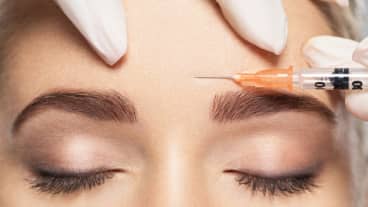 Periorbital Botox for Crow's Feet
Periorbital Botox for Crow's FeetWhy I Switched From Botox To Dysport To Treat My Fine Lines
Consider this my love letter to air-brushed skin.
As a beauty editor, there’s not much I wouldn’t try when it comes to smoothing fine lines and wrinkles. I’ve been obsessed with my anti-aging skincare regimen since my late twenties, and I started getting Botox® in my forehead and around my eyes as another preventative measure by the time I was 30. Every 12 weeks, I would sit in my dermatologist’s chair in New York City and smile as I faced one of my biggest fears – needles. As the years went on, I noticed my Botox® wasn’t lasting as long, and, as someone who is Type A, I began going in every eight to 10 weeks. That’s when the switch from Botox® to Dysport® was recommended.
What’s the Difference Between Botox & Dysport?
The truth is, at a chemical level, there isn’t much of a difference between Botox® and Dysport®. The active ingredient in both neurotoxins is botulinum toxin type A, which means they work in the same way. “All type A botulinum toxins have the same mechanism of action: blocking the release of acetylcholine and preventing the muscles from contracting to maintain the aesthetic effect,” explains Dennis Gross, MD, a board certified dermatologist and founder of his eponymous skincare line.
Botox®, or onabotulinumtoxinA, was first approved by the United States Food and Drug Administration (FDA) to temporarily improve the appearance of frown lines between the eyebrows in April 2002. It has since received more aesthetic approvals, in addition to its therapeutic uses. Dysport® (a.k.a. abobotulinumtoxinA), meanwhile, was first approved to treat glabellar lines in April 2009. Other cosmetic neurotoxins on the market include Xeomin® and, the newest to the scene, Jeuveau®.
While the active ingredient in each product is BoNT-A, they also feature unique protein blends that can affect the diffusion and wear of the injection. “The amount of core active neurotoxin in each on-label dose is different,” Dr. Gross says. “Dysport® has shown to include more core active neurotoxin compared to other neurotoxins.”
Another point of difference? The appearance they each give is very different to my editorial eye. When treating my forehead lines, I find Botox® to give a more localized freezing, whereas Dysport® spreads evenly throughout for a more air-brushed effect. “I love the results that Dysport® gives since the results are natural-looking — fresh but not frozen,” Dr. Gross notes.
How Long Does Dysport Last?
For me, Dysport® lasts about 12 weeks just like Botox® used to. For some, it can last up to five months (yes, I’m extremely jealous of those people). For others, it may be less. “The time length varies from patient to patient depending on genetics – some people break down neurotoxins at quicker rates than others,” Dr. Gross shares.
But that’s not all. How you take care of your skin in between appointments matters, too. He recommends using a consistent skincare regimen that includes active ingredients like vitamin C, retinol, hydroxy acids (alpha and beta), and niacinamide to stimulate collagen production and prolong the life of your treatment.
The best part…
If ever there was a ‘lunchtime procedure,’ neurotoxin injections are it. Dysport® is a quick 10- to 20-minute non-surgical treatment with little to no downtime (you may experience localized swelling, redness, or tenderness at the injection site for about 24 hours). And, unlike some of its competitors that take five to seven days to kick in, Dysport® results start to show in just 48 to 72 hours. Living in a world of instant gratification, I love the quick turnaround.
More Related Articles
Related Procedures

AI Plastic Surgeon™
powered by'Try on' aesthetic procedures and instantly visualize possible results with The AI Plastic Surgeon, our patented 3D aesthetic simulator.

